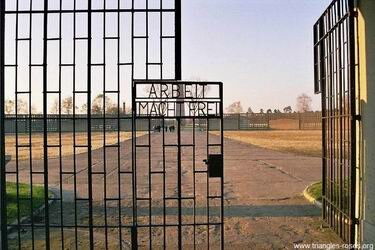
| Think Triangles by Richard Plant |
||||||||||||||||||||||||||||||||||||||||||||
|
The Men with the Pink Triangle, by Heinz Heger, translated and with an introduction by David Fernbach, Boston, Alyson Publications, 1980 This small volume [The Men with the Pink Triangle, by Heinz Heger], which first appeared in 1972 in Germany, must be regarded as a primary source for anyone studying the fate of homosexuals under Hitler. While a few other brief reminiscences by gay survivors exist (all published in German by authors who, like Heger, used pseudonyms), this is the most extensive casebook of any available today.
Heinz Heger shows no political guile. He reports on his daily sufferings and occasional small victories without intellectual pretensions. Ninety percent of his experiences were later authentificated by historians like Eugen Kogon (The Theory and Practice of Hell) and Terence Des Pres (The Survivors), and by the exterminating Lord Inquisitor of German gays himself, Heinrich Himmler, whose decrees and speeches were published many decades later. Those who have seen or read Martin Sherman's Bent will recognize some of the games that the SS men invented for the "queer scum": the meaningless carrying of stones from one side of the field to the other, an activity intended to drive a prisoner mad; the throwing of a prisoner's hat on an electric fence and either forcing him to retrieve it and be eletrocuted or shooting him if he refused. A warning must be inserted here. Readers of Heger's book must withstand explicit description of other injuries inflicted on captives which Sherman, for good reasons, did not dramatize. No audience would sit through the mortification and destruction of a young inmate whose testicles are burned off before he is finished off with a broomstick up his rectum. My warnings refer to this and similar incidents of purgatorial fire. Heger's memoir is not for those who shy away from the darker side of gay history. It demands quiet attention and an occasional suspension of disbelief: how could anybody --straight or gay, Jew, priest or gypsy -- have come out alive ? In the dreaded "clinker works", the quarries of Sachsenhausen, Jews and gays were given the worst jobs: hauling overloaded carts up hills -- where the carts often broke loose and smashed the bodies of those behind -- or were used as living targets on SS shooting ranges. In both Sachsenhausen and Flossenburg, the SS lumped togther the "Jewish pigs" and the "bum-fuckers." As Martin Sherman's play demonstrates, a gay prisoner could sometimes maneuver himself into an easy job which was closed to jewish inmates. This is how Heger kept afloat. But Heger's limited perspective prevented him from observing how Jewish prisoners, a larger and more supportive group, could resist certain demands more effectively than the disorganized homosexuals. If there is any conclusion to be drawn from this memento, it is that the Holocaust was large enough to welcome anybody. To argue over which group was treated worse, Jews, homosexuals, Catholic priests, socialists, or Russian prisoners, seems like arguing whether a patient with cancer deserves more compassion thant a patient with advanced Parkinson's disease. That, according to Heger, one homosexual Jew managed to get out alive must be considered one of the few marvels to be found in these notes from a German gulag for gays.
Fernbach's introduction is also a bit vague about the massive purge of homosexual SA chief Ernst Röhm and his allies, just as he doesn't say enough about the clandestine euthanasia programs that did away with other "deviants" and "unneeded consummers", such as persons affected with blindness, epilepsy, and mental retardation. While American readers may be baffled by the translator's use of certain British vernacular (gay prisoners, for example, had to keep their hands outside their blanket to keep them from "wanking"), all readers should be grateful to Fernbach, who has performed an excellent job as translator and interpreter. What will distress some readers is the fact that young Heger's survival was not due to some unusual spiritual resources within him, nor was he fired by an unshakeable ideological faith. He stayed alive because he could play the part of "dolly boy" in the ancient game plan of prisoners everywhere. Camps were run by "Kapos" -- prisoners who had managed an upward climb in the ranks. The Kapos were either "greens" (former one-time criminals) or "reds" (political prisoners). In the camps, the feuds between greens and reds only stopped when one party was able to oust the other from every important office, or when the Allies at last opened the gates.
Toward 1943-44, thousands of Slavic prisoners suddenly flooded Flossenburg. Official orders were to eliminate them. The camp leadership wals ill-prepared for this onslaught; hundreds of new desk jobs had to be filled, and some old-timers, even a few gays, were moved into safer places. For several weeks in 1944-45, Allied planes precision-bombed the Messerschmidt factories. The SS directorate, furious an jittery, began destroying files and torture instruments. When Allied artillery fire moved closer, the prisoners were forced to march into the nearby woods. Their destination was Dachau. Heger and five other gay Austrians managed to disappear. Others fell down from exhaustion or were shot by panicky SS troopers. (Some troopers, by the way, took the uniforms of the dead inmates to pose as victims, certains that the ignorant victors wouldn't notice the difference. They weren't always wrong.) While preparing his memoirs back in Vienna, Heger apparently did not read statements by other survivors. He dosen't mention the fact that when Dachau was liberated, the prisoners' ravaged bodies couldn't accept the rich food handed them by American soldiers, who couldn't do enough for the living corpses they had incredulously rescued. A number of freed inmates perished during the liberation celebrations, while others didn't last longer than a few months after returning to civilian life. Heger, too, could never escape his memories. He only hints that he had troubles keeping up his studies. He is said to have died recently in Berlin. This is raw stuff, invaluable to those who know we must explore the reasons for the biggest massacre in modern history, if only to determine whether it could in fact happen here, perhaps in another guise, featuring another cast of American-born Hitlers and Himmlers. I hope Heger's testimonial will reach Americans -- straight and gay -- who are beset by considerable worries of their own. Just as I was beginning to go over the English version, I was taken by friends to visit a well-to-do, college-educated stockbroker who had recently acquired his first condominium, a handsome, four-room, well-appointed place. Yet, he complained, the color scheme bothered him and the thermostat did not function well. He knew I was working on a study of gays under Hitler. As we left, he took me aside and said, "Now listen, you lucky guy. You were there with these tough, black-shirted SS men when they played their S-M games. Tell me about it, in hunky detail." I now have the perfect house-warming gift for him: The Men with the Pink Triangle.
|
||||||||||||||||||||||||||||||||||||||||||||
|
||||||||||||||||||||||||||||||||||||||||||||


